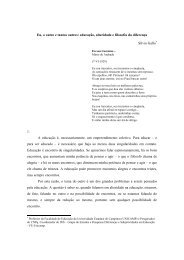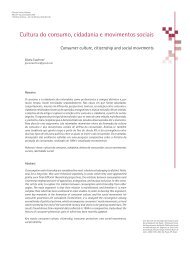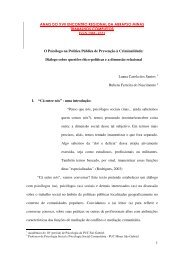Beyond
Beyond Good And Evil Marshall Rosenberg On Creating ... - The Sun
Beyond Good And Evil Marshall Rosenberg On Creating ... - The Sun
- No tags were found...
Create successful ePaper yourself
Turn your PDF publications into a flip-book with our unique Google optimized e-Paper software.
<strong>Beyond</strong>Good & Evil:Marshall Rosenberg On CreatingA Nonviolent WorldAn Interview by D. KILLIANANDY CHARNAS4 e Sun February 2003
I first met Marshall Rosenberg when I was assigned by a localpaper to cover one of his “Nonviolent Communication” trainingseminars. Disturbed by the inequalities in the world andimpatient for change, I couldn’t imagine what use a communicationtechnique could be in solving problemssuch as global warming or the debt of developingnations. But I was surprised by the visibleeffect Rosenberg’s work had on individuals andfamilies caught in conflict.Nonviolent Communication, or NVC, hasfour steps: observing what is happening in agiven situation; identifying what one is feeling;identifying what one is needing; and then makinga request for what one would like to see occur.It sounds simple, yet it’s more than a techniquefor resolving conflict. It’s a different way of understandinghuman motivation and behavior.Rosenberg learned about violence at anearly age. Growing up in Detroit in the thirtiesand forties, he was beaten up for being a Jewand witnessed some of the city’s worst race riots,which resulted in more than forty deaths in a matter of days.ese experiences drove him to study psychology in an attemptto understand, as he puts it, “what happens to disconnect usfrom our compassionate nature, and what allows some peopleto stay connected to their compassionate nature under even themost trying circumstances.”Rosenberg completed his PhD in clinical psychology at theUniversity of Wisconsin in 1961 and afterward went to workwith youths at reform schools. e experience led him to concludethat, rather than help people to be more compassionate,clinical psychology actually contributed to the conditions thatcause violence, because it categorized people and thus distancedthem from each other; doctors were trained to see the diagnosis,not the person. He decided that violence did not arise frompathology, as psychology taught, but from the ways in whichwe communicate.Humanist psychotherapist Carl Rogers, creator of “client-centeredtherapy,” was an early influence on Rosenberg’stheories, and Rosenberg worked with Rogers for several yearsbefore setting out on his own to teach others how to interact innonaggressive ways. His method became known as NonviolentCommunication.No longer a practicing psychologist, Rosenberg admits thathe has struggled at times with his own method, resorting tofamiliar behavior or fearing the risks involved in a nonviolentapproach. Yet each time he has followed through with NonviolentCommunication, he has been surprised by the results. Attimes, it has literally saved his life.On one occasion in the late 1980s, he was asked to teachhis method to Palestinian refugees in Bethlehem. He met withabout 170 Muslim men at a mosque in the Deheisha Camp. Onthe way into the camp, he saw several empty tear-gas canistersalong the road, each clearly marked “Made in U.S.A.” Whenthe men realized their would-be instructor was from the UnitedStates, they became angry. Some jumped to their feet andMarshall Rosenbergbegan shouting, “Assassin! Murderer!” One man confrontedRosenberg, screaming in his face, “Child killer!”Although tempted to make a quick exit, Rosenberg insteadfocused his questions on what the man was feeling, and a dialogueensued. By the end of the day, the man whohad called Rosenberg a murderer had invitedhim home to Ramadan dinner.Rosenberg is founder and director of thenonprofit Center for Nonviolent Communication(www.cnvc.org). He is the author of NonviolentCommunication: A Language of Compassion(PuddleDancer Press) and has justcompleted a new book, to be released by PuddleDancerin fall 2003, on the application of NVCin education: When Students Love to Learn andTeachers Love to Teach. He is currently workingon a third book addressing the social implicationsof Nonviolent Communication.A tall, gaunt man, Rosenberg is soft-spokenbut becomes animated when describing howNonviolent Communication has worked forhim and others. He has three children and currently lives inWasserfallenof, Switzerland. Rosenberg is in great demand asa speaker and educator and maintains a relentless schedule.e day we spoke was his first free day in months. Afterward,he would be traveling to Israel, Brazil, Slovenia, Argentina,Poland, and Africa.Killian: Your method aims to teach compassion, but compassionseems more a way of being than a skill or technique.Can it really be taught?Rosenberg: I would say it’s a natural human trait. Oursurvival as a species depends on our ability to recognize thatour well-being and the well-being of others are, in fact, oneand the same. e problem is that we are taught behaviorsthat disconnect us from this natural awareness. It’s not thatwe have to learn how to be compassionate; we have to unlearnwhat we’ve been taught and get back to compassion.Killian: If violence is learned, when did it start? It seemsto have always been a part of human existence.Rosenberg: eologian Walter Wink estimates that violencehas been the social norm for about eight thousand years.at’s when a myth evolved that the world was created by aheroic, virtuous male god who defeated an evil female goddess.From that point on, we’ve had the image of the good guyskilling the bad guys. And that has evolved into “retributivejustice,” which says that there are those who deserve to bepunished and those who deserve to be rewarded. at beliefhas penetrated deep into our societies. Not every culture hasbeen exposed to it, but, unfortunately, most have.Killian: You’ve said that deserve is the most dangerousword in the language. Why?Rosenberg: It’s at the basis of retributive justice. For thousandsof years, we’ve been operating under this system that saysthat people who do bad deeds are evil — indeed, that humanbeings are basically evil. According to this way of thinking, aFebruary 2003 e Sun 5
DANIEL J. HOFFMANfew good people have evolved, and it’s up to them to be theauthorities and control the others. And the way you controlpeople, given that our nature is evil and selfish, is through asystem of justice in which people who behave in a good mannerget rewarded, while those who are evil are made to suffer.In order to see such a system as fair, one has to believe thatboth sides deserve what they get.I used to live in Texas, and when they would execute somebodythere, the good Baptist students from the local collegewould gather outside the prison and have a party. When theword came over the loudspeaker that the convict had beenkilled, there was loud cheering and so forth — the same kindof cheering that went on in some parts of Palestine when theyfound out about the September 11 terrorist attacks. When youhave a concept of justice based on good and evil, in which peopledeserve to suffer for what they’ve done, it makes violenceenjoyable.Killian: But you’re not opposed to judgments.Rosenberg: I’m all for judgments. I don’t think we couldsurvive very long without them. We judge which foods will giveus what our bodies need. We judge which actions are going tomeet our needs. But I differentiate between life-serving judgments,which are about our needs, and moralistic judgmentsthat imply rightness or wrongness.Killian: You’ve called instead for “restorative justice.” Howis that different?Rosenberg: Restorative justice is based on the question:how do we restore peace? In other words, how do we restorea state in which people care about one another’s well-being?Research indicates that perpetrators who go through restorativejustice are less likely to repeat the behaviors that led totheir incarceration. And it’s far more healing for the victimto have peace restored than simply to see the other personpunished.e idea is spreading. I was in England about a year agoto present a keynote speech at the international conferenceon restorative justice. I expected thirty people might show up.I was delighted to see more than six hundred people at thisconference.Killian: How does restorative justice work?Rosenberg: I have seen it work, for example, with womenwho have been raped and the men who raped them. e first6 e Sun February 2003
step is for the woman to express whatever it is that she wantsher attacker to understand. Now, this woman has suffered almostevery day for years since the attack, so what comes out ispretty brutal: “You monster! I’d like to kill you!” and so forth.What I do then is help the prisoner to connect with thepain that is alive in this woman as a result of his actions. Usuallywhat he wants to do is apologize. But I tell him apology istoo cheap, too easy. I want him to repeat back what he hearsher saying. How has her life been affected? When he can’t repeatit, I play his role. I tell her I hear the pain behind all ofthe screams and shouting. I get him to see that the rage is onthe surface, but beneath that lies the despair about whetherher life will ever be the same again. And then I get the manto repeat what I’ve said. It may take three, or four, or five tries,but finally he hears the other person. Already at this point youcan see the healing starting to take place — when the victimgets empathy.en I ask the man to tell me what’s going on inside ofhim. How does he feel? Usually, again, he wants to apologize.He wants to say, “I’m a rat. I’m dirt.” And again I get him todig deeper. And it’s very scary for these men. ey’re not usedto dealing with feelings, let alone experiencing the horror ofwhat it feels like to have caused another human being suchpain.When we’ve gotten past these first two steps, very oftenthe victim screams, “How could you?” She’s hungry to understandwhat would cause another person to do such a thing.Unfortunately, most of the victims I’ve worked with have beenencouraged from the very beginning by well-meaning peopleto forgive their attackers. ese people explain that the rapistmust have been suffering and probably had a bad childhood.And the victim does try to forgive, but this doesn’t help much.Forgiveness reached without first taking these other steps isjust superficial. It suppresses the pain.Once the woman has received some empathy, however,she wants to know what was going on in this man when hecommitted this act. I help the perpetrator go back to the momentof the act and identify what he was feeling, what needswere contributing to his actions.e last step is to ask whether there is something more thevictim would like the perpetrator to do, to bring things backto a state of peace. For example, she may want medical billsto be paid, or she may want some emotional restitution. Butonce there’s empathy on both sides, it’s amazing how quicklythey start to care about one another’s well-being.Killian: What kinds of “needs” would cause a person torape another human being?Rosenberg: It has nothing to do with sex, of course. It hasto do with the tenderness that people don’t know how to getand often confuse with sex. In almost every case, the rapiststhemselves have been victims of some sort of sexual aggressionor physical abuse, and they want someone else to understandhow horrible it feels to be in this passive, weak role. ey needempathy, and they’ve employed a distorted means of gettingit: by inflicting similar pain on someone else. But the need isuniversal. All human beings have the same needs. ankfully,most of us meet them in ways that are not destructive to otherpeople and ourselves.Killian: We’ve long believed in the West that needs mustbe regulated and denied, but you’re suggesting the opposite:that needs must be recognized and fulfilled.Rosenberg: I’d say we teach people to misrepresent theirneeds. Rather than educating people to be conscious of theirneeds, we teach them to become addicted to ineffective strategiesfor meeting them. Consumerism makes people think thattheir needs will be met by owning a certain item. We teachpeople that revenge is a need, when in fact it’s a flawed strategy.Retributive justice itself is a poor strategy. Mixed in withall that is a belief in competition, that we can get our needsmet only at other people’s expense. Not only that, but that it’sheroic and joyful to win, to defeat someone else.So it’s very important to differentiate needs from strategiesand to get people to see that any strategy that meets yourneeds at someone else’s expense is not meeting all your needs.Because anytime you behave in a way that’s harmful to others,you end up hurting yourself. As philosopher Elbert HubbardAll human beings havethe same needs. when ourconsciousness is focused onwhat’s alive in us, we neversee an alien being in frontof us. other people may havedifferent strategies formeeting their needs, butthey are not aliens.once said, “We’re not punished for our sins, but by them.”Whether I’m working with drug addicts in Bogotá, Colombia,or with alcoholics in the United States, or with sex offendersin prisons, I always start by making it clear to them thatI’m not there to make them stop what they’re doing. “Othershave tried,” I say. “You’ve probably tried yourself, and it hasn’tworked.” I tell them I’m there to help them get clear about whatneeds are being met by this behavior. And once we have gottenclear on what their needs are, I teach them to find moreeffective and less costly ways of meeting those needs.(end of excerpt)February 2003 e Sun 7













